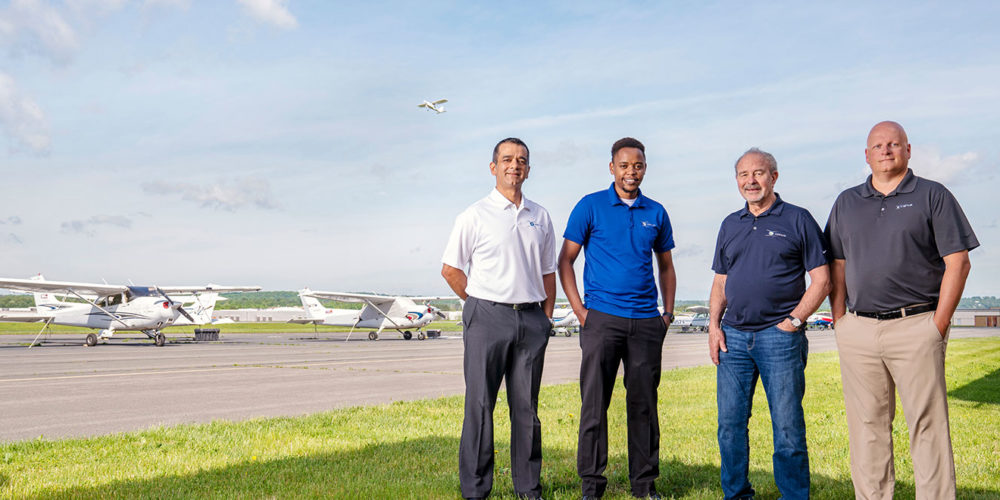Vinayak “Vinnie” Khera (’01) and Florian Hafner, Ph.D. (’99, ’02), first met more than 20 years ago as Embry-Riddle students working together at the university’s Next-Generation ERAU Applied Research (NEAR) lab.
“I have known Florian from the day I walked into Embry-Riddle,” Khera says. “We were both on the varsity tennis team and have been close friends from day one. Since we graduated, we always wanted to do something together.”
Now, Khera and Hafner are working together again at Cignus, their own consulting company, based in Leesburg, Virginia.
“I was at Embry-Riddle to become an aerospace engineer because my parents were against me being a pilot,” Khera says. “It turns out one class was all it took to change my path — it was an airport planning class that focused on modeling and simulation.”
Khera and Hafner now work on modeling and simulation projects for airports and air navigation service providers around the world. With clients in both the private and public sectors in the U.S. and abroad, Cignus specializes in airport and airspace simulation and modeling, air traffic management, systems/software engineering and transportation planning.
Projects Worldwide
One of Cignus’ biggest domestic projects is with the Port Authority of New York and New Jersey, which manages John F. Kennedy International Airport, Newark Liberty International Airport, LaGuardia Airport and Teterboro Airport. The company provides support with airside and airspace modeling and simulation, master planning work, airport layout and terminal facility planning.
“We are also helping them with expansion projects at JFK and LaGuardia airports,” Khera says.
Internationally, Cignus has done airspace and transportation planning work on airport projects in Turkey, Russia, Latvia and United Arab Emirates.
“We did a modeling and simulation project for Dubai International Airport, and it expanded into a regional airspace design for all of the UAE,” Khera says.
Another major international project was an airspace assessment and development/environmental impact analysis, along with modeling and simulation work for the new Istanbul Airport.
Hafner says he sees their work as using technology and analytics to improve operational and planning dilemmas that later guide the engineering behind projects.
“In a way, it is putting math to operational problems,” Hafner says. “It bridges the gap between the technical and operational domains, so we learn to be adept in both.”
With its proximity to Washington, D.C., Cignus also is involved in government work, particularly with the Federal Aviation Administration (FAA). Cignus is working with the FAA NextGen office on a project looking at the integration of unmanned aircraft systems (UAS) into the National Airspace System (NAS). It has also done software engineering work for the FAA to enable spaceport operators to look at the viability of future spaceport sites.
“We try to be as forward-thinking as we can, so commercial space operations planning is definitely something we are looking to do more of in the future,” Khera says.
The Eagle Advantage
Roughly 50% of all Cignus employees are Eagles.
“When we hire new people, we want a specific skillset and a lot of it is geared toward understanding of air traffic, simulation and modeling, and a specific aviation domain understanding. Basically, everyone at Cignus needs to have a passion and love for airplanes,” Hafner says, “So Embry-Riddle is really the first place we look.”
He says he often calls Carlos Castro (’02, ’14), the NEAR lab project manager who now teaches the airport modeling and simulation class, when they are looking for a new employee.
One of their newest “finds” is Aviation Simulation and Modeling Consultant Mwangi “Moh” Karuri (’16, ’19), who was hired in 2019. He works on various transportation planning projects — the most current being a terminal planning project for JFK.
“Every simulation is different, and there are so many dynamic variables to consider,” Karuri says. “You get knowledge from a lot of different areas, and then you can apply the knowledge to develop solutions.”
Director of Business and Corporate Development Tom Styc (’79), who was hired four years ago, was Khera’s former boss and mentor. He is an U.S. Air Force veteran with decades of experience working on FAA projects.
“In business development, it is all about networking,” Styc says. “I planned to retire, but Vinnie brought me back in.”
Looking back, Khera and Hafner credit Embry-Riddle and the NEAR lab for their career trajectory. “Literally, one class and lab paved my career path,” Khera says.
